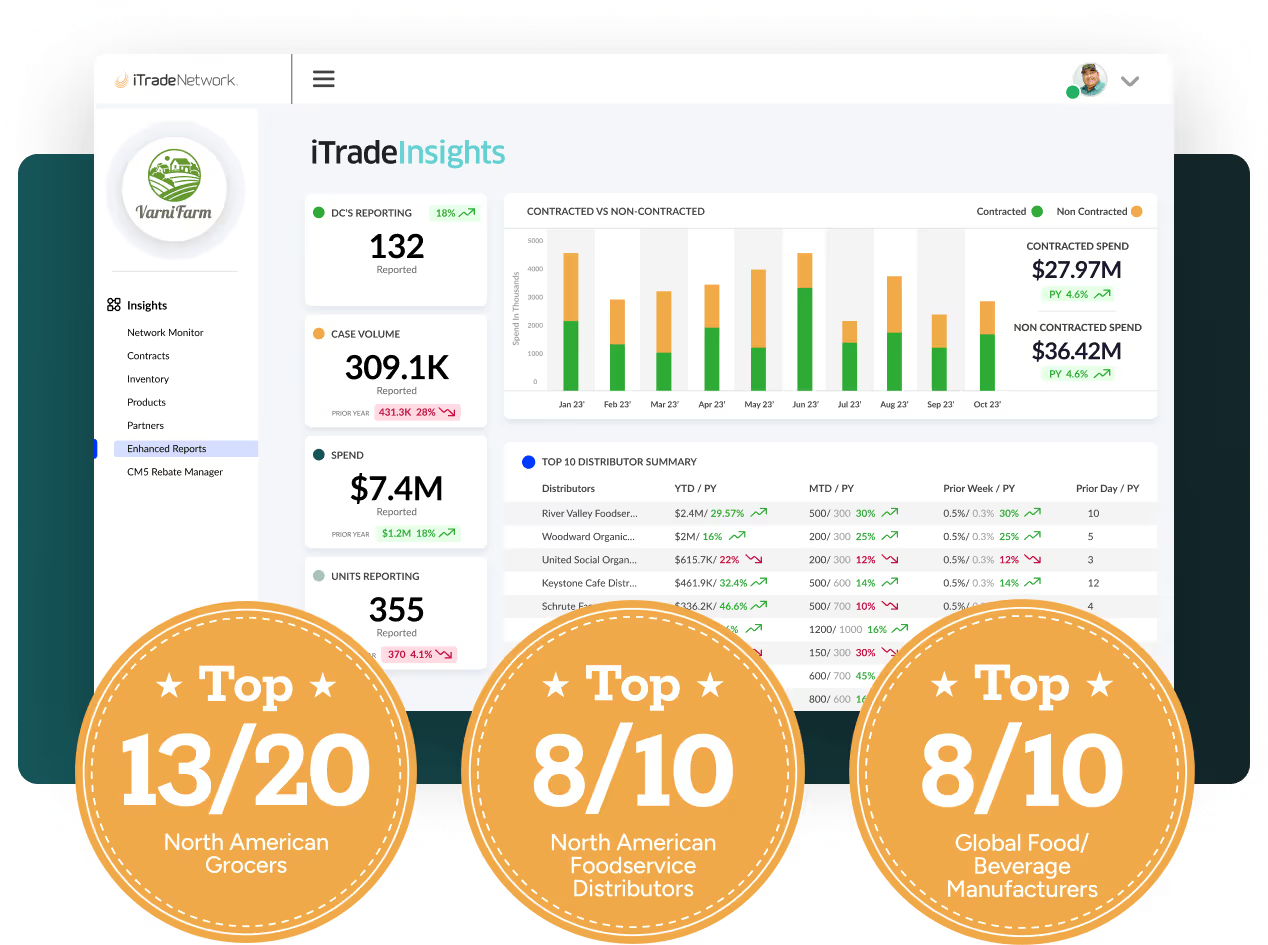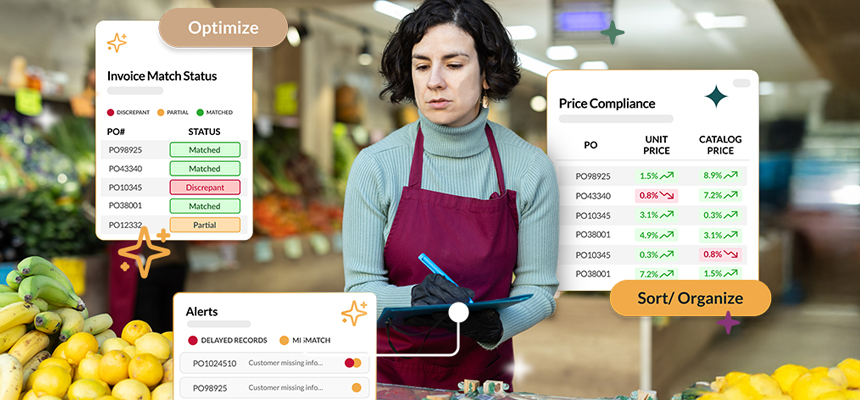The Missing Link in Your Logistical Operations: 5 Ways OMS Crossdock Can Save You Time and Money

With all of the complexities of today’s supply chains, strategies that reduce transport time and provide logistical efficiencies can make or break businesses. This is especially true in the perishables industry, where getting products from their source to their ultimate destination hinges on one key factor: time. The sooner perishables can be transported, the more appealing they’ll be to customers. Consistently fresh produce keeps consumers brand-loyal and fortifies trading relationships. While some companies choose to dramatically increase their spending on operational efficiencies, others have found simpler ways to achieve the same result. Enter Cross-Docking.
What is Cross-Docking?
Cross-Docking is a way to more efficiently transport goods from a variety of sources to a variety of destinations. When trucks transporting different kinds of perishables arrive at the cross dock facility, the products can be unloaded, resorted, and then loaded onto vehicles bound for the next destination, whether that be another distribution center or a grocery store.

Imagine Retailer A has three stores that all need a variety of Company Y Blueberries and Strawberries as well as Company Z Marionberries. Company Y has two trucks—one carrying Blueberries and the other loaded with Strawberries—that have each come from separate growing fields. Company Z has a truck of Marionberries coming from another field thirty miles away.
All three of these trucks arrive at the Inbound Cross-Dock facility where they unload their berry pallets and crates. Sorters will then distribute each load onto all three of Retailer A’s trucks on the Outbound side, filling three trucks with Y Blueberries, Y Strawberries, and Z Marionberries. With the Outbound trucks filled with the proper orders, they can each drive to three separate Retailer A locations and fulfill all the needed berries at each location while minimizing the transport time, ensuring low temperature changes and maximum freshness.

What are the General Benefits of Cross-Docking?
The reduction of transport time by eliminating the need for longer-term storage at cooling facilities and distribution centers isn’t the only way companies benefit by implementing Cross-Docking in their supply chain.
- Cross-Docking also allows for the consolidation of multiple, smaller, Inbound loads into fewer Outbound vehicles. By reducing the need for multiple trucks to all drive farther distances, companies can significantly reduce operational costs for multiple drivers, and less transportation means less pollution in our environment as well.
- These benefits can be seen with the inverse scenario, too; one large Inbound load can be divided up into multiple, smaller batches to be delivered to many locations to prevent one truck from traveling to each one of the intended destinations, ultimately reducing the freshness of those products delivered last.
How does OMS Crossdock work?
The OMS Crossdock Module is an integrated feature of our Order Management System solution that lets companies take advantage of Cross-Docking facilities to the maximum extent. This module allows all three parties involved in cross docking—vendors, buyers, and crossdock facilities—to track the progress of any order and customize status updates and
event notifications. Cross-Docking works best when there’s continuous communication between these three parties, and OMS Crossdock automates that communication through ASNs and Load Status updates to ensure operations run smoothly.
5 Benefits of OMS Crossdock:
- At a time when labor costs make up 14% of grocers’ average revenue, OMS Crossdock reduces the time spent on administering crossdock orders by up to 15%, so employees can focus on other value-adding activities.
- From a study of all of our customers on OMS, Crossdock users are saving up to 40% on delivery costs.
- OMS Crossdock lets companies plan ahead with clear identification of third-party Cross-Dock fees, reducing PO discrepancies.
- By facilitating communications between buyers and sellers, OMS Crossdock strengthens partnerships by giving vendors invoices faster; vendors receive their invoice once the loads arrive at the Cross-Dock facilities, not later when the loads arrive at the final destinations.
- OMS Crossdock also eliminates the need to coordinate with Cross-Dock facilities via phone or email regarding outbound loads, as all communications are done within the OMS solution, centralizing your logistics operations. Improved Cross-Dock communication and coordination means that Logistics Managers can better plan for their Inbound and Outbound loads as well as reduce the costs of temporarily warehousing freight.
Curious to know more?
To see how your company can benefit from OMS Crossdock, schedule a demo to be paired with one of our procurement experts who can answer any questions you may have.
Speak to an Expert
Take a closer look at the platform built for buyers and their trading partners

The Missing Link in Your Logistical Operations: 5 Ways OMS Crossdock Can Save You Time and Money
With all of the complexities of today’s supply chains, strategies that reduce transport time and provide logistical efficiencies can make or break businesses. This is especially true in the perishables industry, where getting products from their source to their ultimate destination hinges on one key factor: time. The sooner perishables can be transported, the more appealing they’ll be to customers. Consistently fresh produce keeps consumers brand-loyal and fortifies trading relationships. While some companies choose to dramatically increase their spending on operational efficiencies, others have found simpler ways to achieve the same result. Enter Cross-Docking.
What is Cross-Docking?
Cross-Docking is a way to more efficiently transport goods from a variety of sources to a variety of destinations. When trucks transporting different kinds of perishables arrive at the cross dock facility, the products can be unloaded, resorted, and then loaded onto vehicles bound for the next destination, whether that be another distribution center or a grocery store.

Imagine Retailer A has three stores that all need a variety of Company Y Blueberries and Strawberries as well as Company Z Marionberries. Company Y has two trucks—one carrying Blueberries and the other loaded with Strawberries—that have each come from separate growing fields. Company Z has a truck of Marionberries coming from another field thirty miles away.
All three of these trucks arrive at the Inbound Cross-Dock facility where they unload their berry pallets and crates. Sorters will then distribute each load onto all three of Retailer A’s trucks on the Outbound side, filling three trucks with Y Blueberries, Y Strawberries, and Z Marionberries. With the Outbound trucks filled with the proper orders, they can each drive to three separate Retailer A locations and fulfill all the needed berries at each location while minimizing the transport time, ensuring low temperature changes and maximum freshness.

What are the General Benefits of Cross-Docking?
The reduction of transport time by eliminating the need for longer-term storage at cooling facilities and distribution centers isn’t the only way companies benefit by implementing Cross-Docking in their supply chain.
- Cross-Docking also allows for the consolidation of multiple, smaller, Inbound loads into fewer Outbound vehicles. By reducing the need for multiple trucks to all drive farther distances, companies can significantly reduce operational costs for multiple drivers, and less transportation means less pollution in our environment as well.
- These benefits can be seen with the inverse scenario, too; one large Inbound load can be divided up into multiple, smaller batches to be delivered to many locations to prevent one truck from traveling to each one of the intended destinations, ultimately reducing the freshness of those products delivered last.
How does OMS Crossdock work?
The OMS Crossdock Module is an integrated feature of our Order Management System solution that lets companies take advantage of Cross-Docking facilities to the maximum extent. This module allows all three parties involved in cross docking—vendors, buyers, and crossdock facilities—to track the progress of any order and customize status updates and
event notifications. Cross-Docking works best when there’s continuous communication between these three parties, and OMS Crossdock automates that communication through ASNs and Load Status updates to ensure operations run smoothly.
5 Benefits of OMS Crossdock:
- At a time when labor costs make up 14% of grocers’ average revenue, OMS Crossdock reduces the time spent on administering crossdock orders by up to 15%, so employees can focus on other value-adding activities.
- From a study of all of our customers on OMS, Crossdock users are saving up to 40% on delivery costs.
- OMS Crossdock lets companies plan ahead with clear identification of third-party Cross-Dock fees, reducing PO discrepancies.
- By facilitating communications between buyers and sellers, OMS Crossdock strengthens partnerships by giving vendors invoices faster; vendors receive their invoice once the loads arrive at the Cross-Dock facilities, not later when the loads arrive at the final destinations.
- OMS Crossdock also eliminates the need to coordinate with Cross-Dock facilities via phone or email regarding outbound loads, as all communications are done within the OMS solution, centralizing your logistics operations. Improved Cross-Dock communication and coordination means that Logistics Managers can better plan for their Inbound and Outbound loads as well as reduce the costs of temporarily warehousing freight.
Curious to know more?
To see how your company can benefit from OMS Crossdock, schedule a demo to be paired with one of our procurement experts who can answer any questions you may have.
Unlock It Now!




